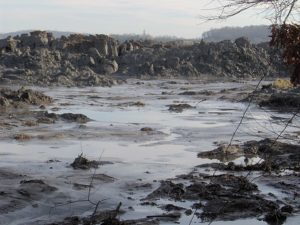
View of the TVA Kingston Fossil Plant fly ash spill (image credit: Brian Stansberry)
When coal is burned for power, a residue called coal ash is left behind.
“It contains a slew of toxic pollutants such as arsenic, cadmium, and selenium,” says Lisa Hallowell of the nonprofit Environmental Integrity Project. She says utilities used to frequently dispose of coal ash in unlined ponds that could leak into ground and surface water.
But in 2015, coal ash disposal was federally regulated. New impoundments must be lined to minimize risk.
“We finally do have federal regulations which is great,” says Hallowell.
And a recent court decision mandates that older unlined impoundments must retrofit or close…
“…which will be safer for all of the communities that live near these sites.”
Hear Hallowell explain more about sites that are closing:
Get Schooled:
- Read more about the recent court decision from the Environmental Integrity Project.
- Learn more about coal ash and water pollution from CBS news.
The fine print:
- This segment was produced in partnership with Cornell University’s Atkinson Center for a Sustainable Future and made possible by the Foundation for Pennsylvania Watersheds.




